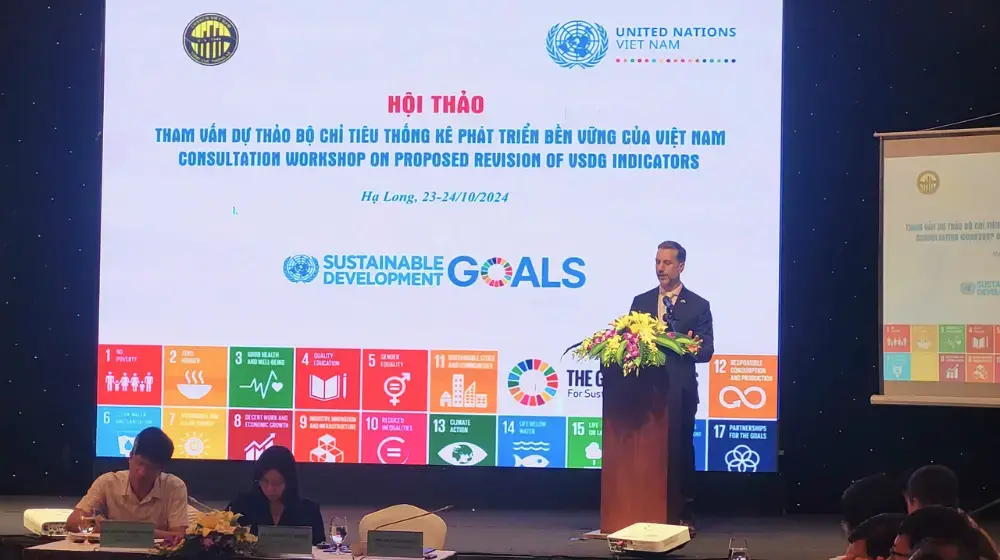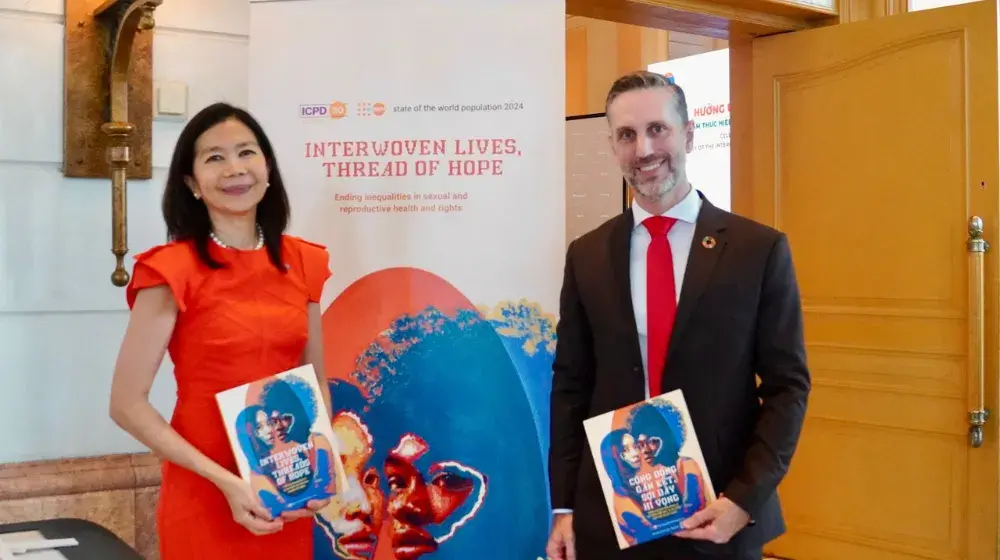Mr. Pham Quang Vinh, Deputy Director, General Statistics Office,
Representatives of MPI’s departments/GSO, line-ministries,
Representatives of international organizations, research institutions, UN colleagues,
Ladies and Gentlemen,
Very good morning to you all,
I am delighted to be here today to attend the Consultative Workshop on Development of the Population Related Statistical Indicators of the Viet Nam Sustainable Development Goals Statistical Indicator System. This workshop is one of the important activities in the Government’s road-map to develop the indicator system for submission to the MPI Minister (in December 2018). Let me from the outset congratulate the General Statistics Office for its tremendous commitment to and efforts in localizing SDGs indicators for monitoring and evaluating the National Action Plan to implement the 2030 Agenda for Sustainable Development.
Ladies and Gentlemen,
The Agenda 2030 with 17 goals and 169 targets is a very challenging proposal that need all of society together to contribute to the implementation of the sustainable development goals by the year 2030 as its goals and targets are interlinked and indivisible and balance the three dimensions of sustainable development: the economic, social and environmental.
In Viet Nam, the Decision approving the National Action Plan to implement the 2030 Agenda for Sustainable Development was signed on 10th May 2017 by the Prime Minister, which demonstrates Viet Nam’s strong political commitment to sustainable development goals and its road map Agenda 2030.
Since the adoption of the Action Plan, a number of important activities have been organized, including the preparation of the roadmap for implementation of the SDGs of Viet Nam; the development of specific guidelines on mainstreaming Viet Nam’s SDGs into socio-economic development plans of ministries and provinces; the formulation of ministerial and provincial action plans to implement SDGs, and the development of the Voluntary National Review (VNR) for the UN’s high-level Political Forum on Sustainable Development in July 2018. These activities are all closely related to the use of statistical indicators to measure progress of SDGs of Viet Nam.
The Ministry of Planning and Investment (MPI) has been assigned by the Government to lead and coordinate with other ministries, organizations and provinces in the development and adoption of sustainable development indicators. The GSO/MPI has established the editorial team in April 2017 to conduct a review on the current status of SDG indicators in Viet Nam; reviewed on the relevance and feasibility of global SDG indicators; and proposed statistical indicators for monitoring and evaluating the implementation of Viet Nam’s SDGs.
This workshop aims at sharing and obtaining inputs from participants on the proposed Viet Nam’s SDG indicators, particularly the population related indicators. Given the ‘No one is left behind’ and “People are the center of development” principles, the development of population indicators in the sustainable development indicator system is critical. Many of these indicators are being collected and compiled in population surveys, the coming Population and Housing Censuses 2019, specialized surveys, and administrative data system. For example, the 2019 Census will provide about 9% of the total SDG indicators of goal 1, 3, 5, 7, 8 and 16 (such as maternal mortality, infant mortality, causes of death, birth registration, child marriage, early marriage and childbearing, access to basic social services, etc.) with the understanding that population data will provide solid denominators to estimate many other SDG indicators. Given the duration of the Agenda 2030 and the fact that the Population and Housing Census will fall in that period, it would be very interesting to see if the relation between the two principles measured by data system could be strengthened further. Therefore, SDG indicators will allow monitoring and evaluation of the progress in implementation of the 2030 Agenda and other policies in Viet Nam and be used as evidence for decision making.
I would like to take this opportunity to share with you some key messages relating to SDG indicators that the UN agencies would like to emphasize:
Firstly, SDG indicators are based on international standards, have been developed through intensive technical work (UN Statistical Commission, etc.) and already have an important level of buy-in from member States. This should guide stocktaking exercises and data gap analysis, ensuring that localization of indicators is done in compliance with recognized international standards and agreed definitions. It is highly recommended that SDGs indicators are adopted, to the extent possible, as originally formulated. Adjustment of SDGs indicators will impact on the level of global comparison.
Secondly, disaggregation according to globally defined SDGs indicators (as specified in metadata) is critical for global comparison and identification of exclusion and inequity: For those SDGs indicators that Viet Nam selected to monitor and report on SDGs progress toward achievement, defined disaggregation of data should be followed. Inclusion of SDGs indicators into the national statistical indicator system will determine sustainability of data collection, analysis and dissemination.
Thirdly, both traditional (national surveys, administrative data) and non-traditional types of data (big data and other real time monitoring data) should be collected to calculate SDGs statistical indicators. Participation of wide stakeholders (government, private sector, CSOs, academia etc.) in generate data and monitoring indicators will be critical. Support to data producers is not enough. It is also important to promote a holistic approach to data production and use. Having SDG indicators for tracking can contribute to transparency and coordination among partners at national, sub-national, and sectoral levels, in data production and utilization for decision making.
Last but not least, the achievement of the 2030 Agenda for Sustainable Development and the Sustainable Development Goals will require different sectors and actors working together in an integrated manner by pooling financial resources, knowledge and expertise. In our new development era with 17 intertwined Sustainable Development Goals and 169 associated targets as a blue-print for achieving the sustainable Future We Want, cross sectorial and innovative multi-stakeholder partnerships will play a crucial role for getting us to where we need by the year 2030.
Ladies and Gentlemen,
The 2030 Agenda challenges all of us to broaden our partnerships in “All of Society-framework” and to think, work and deliver sustainable development and ensure that Agenda 2030 is implemented effectively, and that no one is left behind.
UNFPA in Viet Nam and other UN Agencies have been working closely in supporting GSO, line ministries and other sectors in the development of, collection of information for, and calculation of Viet Nam SDGs indicators. We will continue to collaborate and coordinate to ensure that our supports are effective. Capacity building in development, collection and accessibility of statistical data for monitoring and evaluation of SDGs is the top priority of development partners in the coming years.
I hope that at the today's workshop we will have useful discussions to contribute to the improvement and finalization of Viet Nam’s SDGs statistical indicators in general and population-related in particular.
Thank you for listening and participating in the workshop. Wish you all good health, happiness and success.



